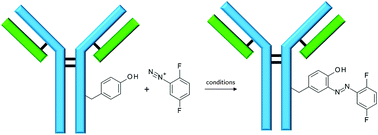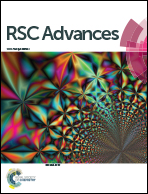A study on the trastuzumab conjugation at tyrosine using diazonium salts
Abstract
Herein, we report on the conjugation of trastuzumab with 2,5-difluorobenzene diazonium tetrafluoroborate. According to the amount of diazonium salt used, an average loading of 1.0 to 3.8 azo compounds per antibody was found. Tryptic digestion and subsequent MS–MS analyses allowed the identification of the main conjugation sites. Furthermore, additional conjugation reactions of trastuzumab with 4-formylbenzene diazonium hexafluorophosphate (FBDP) allows us to make a short study on the influence of the different reaction parameters on the outcome of the conjugation reaction, both in terms of antibody loading and of conjugation sites. In all cases, antibody conjugation was achieved with full selectivity towards tyrosine residues.


 Please wait while we load your content...
Please wait while we load your content...